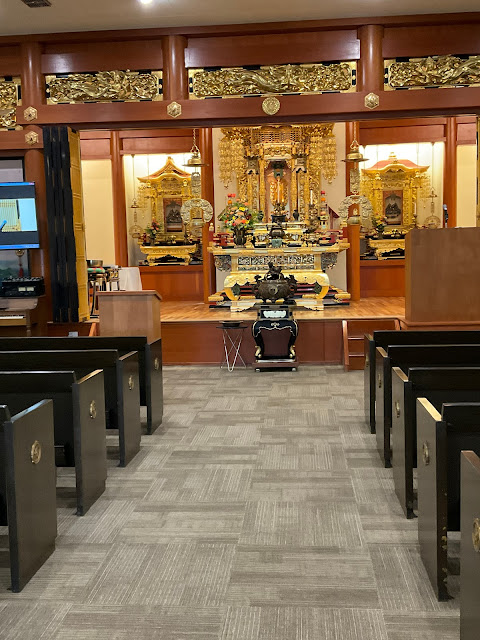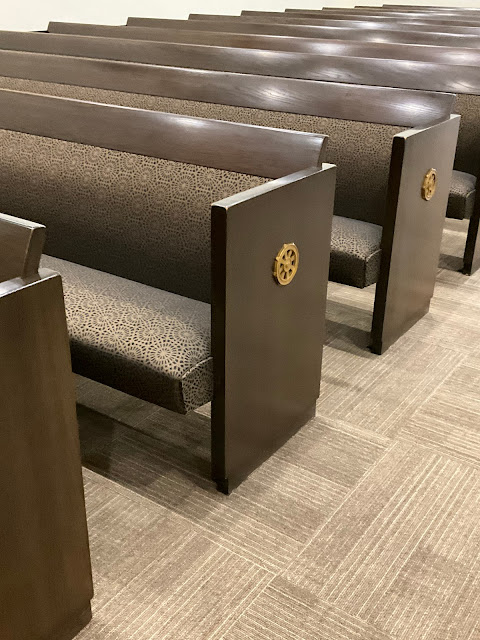Our Refurbished Pews and the Value of Sitting Together
NOTE: For our blog this month, we wanted to share Rev. Anne Spencer's Dharma Talk for the November 2023 Shotsuki (Monthly Memorial Service)
Image: Picture of the Idaho-Oregon Buddhist temple in Nov 2023 after the altar has been cleaned and the new carpet and refurbished pews put in place.
Though you have gone to Buddha land, my thoughts are on
you. As I long to see you, your face
floats before my eyes as I intone the Buddha’s name.
How joyous! The Compassion of the Buddha now fills our being. As for us, we turn to you while intoning the Nembutsu.
Isn’t it fun to watch our temple being put back together after the fire? Today many of you are getting to experience having our pews back. These are the same pews we had before the fire but with new upholstery. And we made some changes to the configuration here in the front and on the sides to make it easier for people to get in and out and to move around. But these are not new pews, they are our pews—the ones that have been at the temple for decades.
Image: Our old pews with new springs, upholstery, and finish
And in honor of the return of the pews, I wanted share some
thoughts on sitting. Not just sitting,
but sitting together, sitting and being together with our sangha. Not running around and doing things, not
coming and going, but sitting together, sharing time and space together. Genuinely
appreciating being in the presence of those around us.
The second stanza of the gatha I just read says “Today, when spreading the mat to hear the
teachings, I turn to you. Come to us now
at this gathering for friends who remain.”
Traditionally, in Asia, Buddhists sat on the ground or the floor to hear
the dharma. But because the ground is
dirty or hard, people would bring special mats, cushions, or carpets to sit on
while they, surrounded by their community, listened to the Buddhist teachings. Can’t you imagine people coming together,
looking around for their friends, exchanging greetings, and then spreading out their mats near friends and family, to sit and listen to the Dharma
surrounded by their loved ones?
It’s just like coming into the hondo, the main hall of the
temple, and looking around in the pews for a friend or family member to sit
with. It’s a happy feeling when you find them. There are smiles and waves and
gestures to “come sit over here.” Or “I
saved you a spot.” And if you are a visitor, it is lovely when one of the
regulars motions you over to a spot by them—it is so welcoming! Our pews, then,
serve the same purpose as the mats referred to in the gatha. The mats and the pews represent the intention
to stay in one place for a while.
Sitting down shows a commitment of time and attention to the place the
we are in and the people we are with. Our
sitting down demonstrates that we want to be here.
How many friendships have these pews seen over the years? Who
have you sat with here? For those of you who have been coming for many decades,
who do you remember your parents or grandparents sitting with? How many people have comforted friends and
family in these pews during funerals or difficult times? Or maybe celebrated a
holiday or a wedding here? A LOT has happened in these pews over the years.
As I read the names on the shotsuki list, how many of you had
memories of spending time with one or more of these people? Do you remember sitting with them during
service, or a meal afterwards, or at a family or community event?
I have a memory that I wanted to share today of Debbie Ogura,
whose name is on our list this month. I
met Debbie on Sept 12, 2005. The Dalai Lama was speaking in Sun Valley Idaho.
And Ruth and Hideo Harada invited both Debbie and me to come with them—I
believe that they had 4 tickets and they wanted us to be their guests. Several of the Buddhist groups in Idaho got
together and chartered a bus up there. Ruth wanted Debbie and me to become
friends and so she arranged for the 2 of us to share a seat on the bus. Debbie and I sat together and talked the
whole way up to Sun Valley and the whole we back—it was a great time and afterwards
she and I planned to stay in touch. That was Sept 12 of 2005. On Nov 30, 2005 Debbie died suddenly. It was shocking! And I was so grateful for that time we had
together and so happy that we had had the drive to Sun Valley and back just sit
together and become friends that day. That
was our only chance to be friends and I am so glad we took full advantage of
our time together.
Our Buddhist teachings tell us that everything is impermanent
and death is a normal part of life. This teaching reminds us to appreciate each
moment we have with each other and to not take our own life or the lives of
others for granted. Getting to sit together with another person is a gift that
we should appreciate whenever we have the chance. Inviting others to sit with
us is something we can do to make the world a better place. The teachings also
remind us that all things are interconnected and that our memories and
connections with the deceased are real
and meaningful even after death. As we
sit in the temple, at home, in a coffee
shop, or even on a bus, we can continue to remember and appreciate the time we get
to share with others.
And take a moment to appreciate the pews—oh the stories of
friendship they could tell!







Comments
Post a Comment